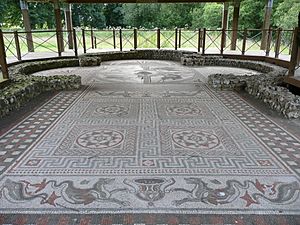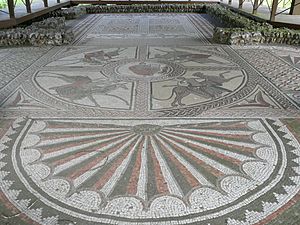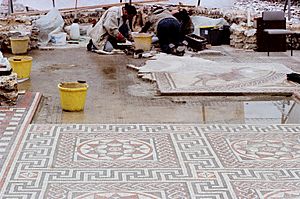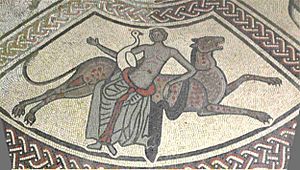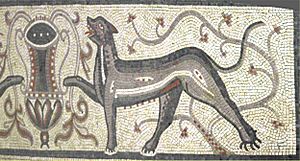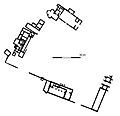Littlecote Roman Villa facts for kids
Littlecote Roman Villa is an ancient Roman house and religious site in Wiltshire, England. It is located at Littlecote Park, near the village of Ramsbury. This special place has been dug up by archaeologists, and you can visit it to see what life was like long ago!
Contents
The Villa's Story
Early Days and Farming Life
The story of Littlecote probably started as a small army camp. It might have guarded a place where people could cross the River Kennet. Around the year AD 70, local people built round farming huts here. About fifty years later, a Roman-style rectangular building took their place. People used this building for baking, making malt (for brewing), and grinding grain.
Building the Grand Villa
Around AD 120, a much bigger house was built. This was a large, two-story "winged corridor villa." This means it had long hallways with rooms sticking out like wings on either side. It even had its own bath suite inside! Over the next few centuries, the villa changed several times. A big renovation happened around AD 270. The villa had many beautiful floor mosaics. There were also separate workshops, barns, and a large gatehouse.
Becoming a Religious Center
Around AD 360, the site changed from a farm to a religious center. We know this from old coins found there. A large barn was turned into a courtyard. A very early "triconch" hall was built next to it. A triconch hall is a room shaped like a three-leaf clover. This hall had its own bath suite.
On the floor of this new hall, a famous Orpheus mosaic was laid. This amazing mosaic was first found in 1727. It shows the mythical musician Orpheus. Experts believe this mosaic and the hall were part of a pagan religious center. It might have been used to worship Roman gods like Bacchus and Apollo. Other buildings may have been changed to host visitors who came on pilgrimages. This change happened during a time when some people tried to bring back old Roman religions.
The End of the Roman Era
Many of the buildings at Littlecote were pulled down or fell apart around AD 400. This happened shortly after new laws were made against pagan religions. It was also just before the Romans left Britain. Archaeologists have also found two timber buildings from after the Roman period on the site.
Images for kids


